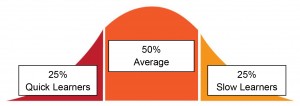2016 CLOSING THE SALE
What Would You Do If You Were Me?
 For several years now, so many prospective buyers and sellers have chosen to throw logic to the wind by making unreasonable demands. It’s all a reasonable agent can do to avoid getting frustrated and just giving up on these stubborn clients. That’s not a good strategy because you can’t lose unless you decide to give up. So, instead of getting frustrated, attack the problem with one logical solution after another using spaced-repetition. Remember the Bell Curve in education? Think about your clients as being like students in a classroom.
For several years now, so many prospective buyers and sellers have chosen to throw logic to the wind by making unreasonable demands. It’s all a reasonable agent can do to avoid getting frustrated and just giving up on these stubborn clients. That’s not a good strategy because you can’t lose unless you decide to give up. So, instead of getting frustrated, attack the problem with one logical solution after another using spaced-repetition. Remember the Bell Curve in education? Think about your clients as being like students in a classroom.
- Approximately 25% of the students (your buyers and sellers) will absorb the information very quickly. It doesn’t take a good teacher to teach this group and it doesn’t take a good agent to be successful with this group. They just get it.
- Another 50% absorb the information or learn within a reasonable period of time. It takes a good teacher with patience to get most of these students, in much the same way that a good agent will be successful with another 50% of the buyers and sellers.
- The last group is comprised of slow learners. It doesn’t mean they aren’t as smart as the others; they just process the information differently or are more stubborn than the normal student. We have all come across buyers and sellers that fit into this category. They’re the ones that can drive you crazy.
There are two different strategies for dealing with the slow-learning group:
- Get rid of them and move on to the easier clients – This is a sound strategy if you already have too many good clients. If you don’t, it means you will make a lot less money.
- Identify a strategy that will allow your slower buyers and sellers to grasp the information more quickly. The effective strategies for most clients won’t work with this group so you have to be more patient and more creative.
One great approach to use with buyers and sellers that have been frustrating is to open their eyes by putting them in your shoes. This can be easily done by presenting the logical facts and asking them how they would handle the situation if the roles were reversed and they were representing someone like themselves. Ask the slow learners, “What would you do if you were in my shoes?”
Consider the following examples:
- A seller refuses to lower his price – Place the research in front of your stubborn seller and ask, “Mr. Obstinate, if you were me and you wanted to give your client the best possible service and it was obvious from the data that the price was questionable but your client was choosing to ignore the data, what would you do?” Your clients answer to this question will be most telling.
- A buyer chooses to put low ball offers in for one home after another, only to lose out to better offers – Insanity, we’ve placed 14 offers on desirable properties at desirable prices and lost everyone because the offer was too low? If you were in my shoes and you knew that this strategy wasn’t going to work, how would you convey that message to your prospective buyer?” Once again the answer could provide the solution to getting the buyer to change their strategy.
- A seller has unreasonable expectations about communication – You ask Mr. Unreasonable, “I have every intention of giving you the highest level of service, but calling you every week when there is nothing to report may not make sense. This is the time I should be spending identifying the next step to selling your listing. If you were me, and you really wanted to please your client but felt there was a better approach, what would you do?”
As you can see, asking your clients to look at the situation from a different perspective can be a most effective way to “teach” them to make better choices in meeting their goals.